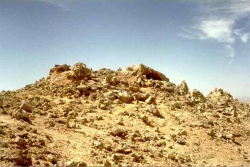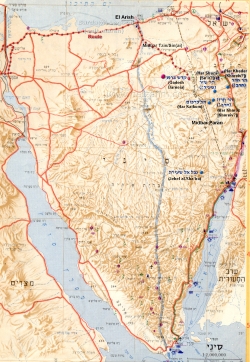|
 |
![]()
Cleaning The Feculent Mantle Of RibꞋi Yᵊho•shuꞋa
Restoring Authentic—Har Sin•aiꞋ— Tor•âhꞋ
 |
To be a follower of the authentic and historical Ribi Yᵊho•shuꞋa requires that you follow his teachings and pray like him. The Christian must ask himself or herself, "How did it happen that Christianity is so alien to his history as a Pharisee rabbi, his people the Pharisee (today's Orthodox) Jews, Pharisee-Orthodox synagogues in which he prayed and taught, the Hebrew language in which he prayed and everything Judaic—Tor•âhꞋ and Ha•lâkh•âhꞋ—that he taught and held most precious? Why is Christianity so dissimilar to the Judaism of RibꞋi Yᵊho•shuꞋa and so similar to Roman Hellenist idolatry???
 250x149.jpg) |
One can only understand this historical Jew within the setting and constraints of first-century Torah and religious first-century Jews. Thanks to the recent scholarship of Prof. Elisha Qimron, Dead Sea Scroll 4Q MMT has, for the first time in nearly 2,000 years, vividly and clearly set forth these constraints. Only within the environment described in MMT does the contrast demonstrated by the late Oxford historian James Parkes (The Conflict of the Church and the Synagogue, A Study in the Origins of Anti-Semitism), between first-century pro-Torah Judaism — taught by RibꞋi Yᵊho•shuꞋa — and post-135 C.E. antinomian Roman Hellenist Displacement Theology — the birth of Christianity, come into sharp focus.
 |
4Q MMT was written no later than the 1 century B.C.E., at least 6 centuries before Tal•mudꞋ was compiled (5th century C.E.). "First of all, one should note that MMT is a written halakhic text from the Second Temple period. As has been pointed out, the Pharisees at that time maintained the principle of not writing down halakhot, believing that the Torah was the only written law, and that it had been transmitted from Sinai together with an oral law; henceforth no prophet would have the authority to introduce any halakhic innovation" (Qimron, Elisha, Discoveries in the Judaean Desert • X, Qumran Cave 4 • V, Miqsat Ma'ase ha-Torah ("Some Halakhah of the Torah), Oxford, 1994, p. 132).
"This [MMT] scroll will undoubtedly stand in the centre of all future discussion of the halakha and identity of the sect and the history of the halakha in general" (Ya'akov Sussmann, Qimron, p. 185).
Ha•lâkh•âhꞋ, the Quintessence of all 1st Century Jews
"In practice, the Pharisees clashed over the observance of the temple laws with the descendants of the Sadducean high priests in Jerusalem, and not with the separatist sects who had left the city and settled in the desert" (Ya'akov Sussmann, Qimron, p. 195).
"Observance of the Torah's laws and the milieu of the halakha were the central factor in Jewish life during this period. The assertion that 'there was no factor, force or event which made so significant an impression on the history of the Jewish people, molded its life and forged its character, as the halakha', is particularly appropriate about the Second Temple period, not only with respect to the Pharisees, but also about their opponents, who scrupulously observed the law according to the Sadducean tradition. Not only observance of the Torah's commandments, but also preoccupation with the proper interpretation of the law in its most minute details, stood in the center of their spiritual world. The halakhic minutiae, concepts, and terms of the talmudic sages that we find in the Mishna of the later Tannaim and which occasionally appear to the result of late, abstract rabbinic speculation, actually have their roots in this period; they now come alive in front of our eyes as a concrete historical reality, in contemporary documents stemming from Hasmonean times. The people toiled over the halakha and meditated upon it; they clashed over it and divided because of it. Extremists who refrained from joining members of the other camp, refusing to associate with them and 'rely upon them', 'separated from the majority of the people' until they were almost completely forgotten" (Ya'akov Sussmann, Qimron, p. 197).
This was the world into which the 1st-century C.E. Jew from Beit-LëkhꞋëm was born, educated, earned the Pharisee sᵊmikh•âhꞋ of RibꞋi from the Beit-Din hâ-Jâ•dolꞋ—for being a learned and Tor•âhꞋ-correct Pharisee—and was killed by Roman occupiers who considered his Royal Lineage in Beit-Dâ•widꞋ to be a political threat to Caesar and the Roman Empire.
Whoever ardently desires to find and follow the authentic RibꞋi Yᵊho•shuꞋa must shed all contaminations of the idolatrous 135 C.E. Roman-Hellenist apostasy and adopt, instead, the documented and demonstrated authentic teachings of RibꞋi Yᵊho•shuꞋa — Torâh, uncompromised and untainted. However, today‘s Christian Jew or gentile Christian cannot recognize and follow the authentic RibꞋi Yᵊho•shuꞋa without first recognizing that what he or she now follows is apostate, counterfeit, anti-Torâh — and intractably antithetical to the authentic teachings of pro-Tor•âhꞋ RibꞋi Yᵊho•shuꞋa.
The question, therefore, is not whether we meet your expectations but rather whether you will remold yourself to the well-documented and demonstrated authentic teachings of RibꞋi Yᵊho•shuꞋa — Torâh.
The restoration of Israel in 1948 signaled the beginning of bringing down the curtain on the great apostasy begun in 135 C.E., known as the ‘Times of the Gentiles.‘ Authentic followers of historical RibꞋi Yᵊho•shuꞋa — Jews and non-Jews — will find in the
Google+ registered author & publisher


